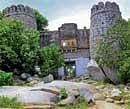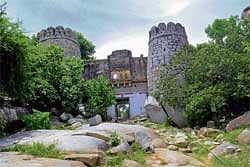

As a traveller, one is always on the lookout for unusual experiences, but Anegundi is what I would call a “trip”. I have always enjoyed being on the road, exploring many a town by foot or going on the occasional road trip, but this one took the wind out of my sails.
I was visiting Anegundi after almost a decade. Although I had been to Hampi many times, this ancient town had always eluded me. So, when I promised myself a date with the mythical Kishkindha of Ramayana, as Anegundi is believed to be, Virupaksha , my guide, looked rather worriedly at his watch and said, “Madam, you have just three hours over there and then you need to come back to Hampi and later catch your train.” I didn’t have a choice. So I let him customise my itinerary and blindly followed him.
The first thing that I saw was the crumbled remnants of what was once a bridge between Hampi and Anegundi across the Tungabhadra. Just when I had gotten over the eyesore, Virupaksha announced that we would cross the river in a coracle. I wasn’t really worried until I saw the coracle. Our boat arrived, shaped like a circular basket, made of cane, bamboo and some plastic sheets. Sailing along with us were another eight men, a couple of them travelling with their bikes.
I sat on the rim of the coracle and swirled around, looking at the mountains, worried that it might topple any moment. I mentioned to Virupaksha that I did not know swimming, but he comforted me saying that the coracle was used to ferry people even during the Vijayanagar era. Looking at my rather skeptical face, he donned the role of a serious guide and referred to Robert Sewell’s book, A Forgotten Empire, which quoted the 16th century Portuguese traveller, Dominoes Paes. I later looked up the book and Paes indeed had observed that the coracle was used to carry “fifteen to twenty persons and even horses and oxen can cross in them if necessary.” Thank God, I thought to myself, that I had to deal with only bikes.
Story of an ancient kingdom
The journey was rather quick and I saw a visibly excited Virupaksha gushing with pride as he described his hometown. “Anegundi is older than Hampi – in fact this is the mother kingdom. When the Delhi Sultans invaded Warangal, two brothers called Harihara and Bukka escaped and landed here first. They later founded the Vijayanagar city on the other bank,” he added, referring to Hampi.
A fisherman and his wife were busy making nets near the Tallarighatta gate or the erstwhile toll gate as we sipped tea in a small shack , owned by some women. Virupaksha meanwhile quietly arrived on the scene with an autorickshaw and that was when the real “trip” started. I had travelled in all modes of transport, but this was my first experience of “a hop on hop off auto rickshaw tour” .
The auto buzzed off in top speed as the hills circled us. The roads were bumpy and narrow and virtually empty. We drove down the charming village of Anegundi, a lively settlement with a few mahals and monuments like the Gagan Mahal.
The Ramayana connection
We left the village behind us and stopped at the many gates of the fortified town to take photographs. The auto veered past lush fields as Virupaksha spoke about his career as a guide with an auto rickshaw. He rattled off names of celebrities who had sought his services and in between he gave us some history of Anegundi. Besides the Ramayana connection, pilgrims consider it holy as the Pampa Sarovar flows here. Even today, the royal descendants of the Vijayanagar empire are believed to reside here in this village.
The houses gave way to fields as we continued chugging around. But for the occasional nomads and their herd of horses, we encountered neither a bullock cart nor another vehicle. We learnt that we were headed to the Durga temple and the Anegundi Fort entrance.
We slowly left the plains and followed the curves of the road and drove uphill. The boulders looked much closer as I realised that this was the first time I was driving up a hillock in an auto. There was no one in sight – just the bare landscape and us in a lone rickshaw. After almost half an hour, we stopped at the foothill of a hillock. A long flight of steps led to a quiet unassuming Durga temple where a couple of dogs were lying around. The walls of the courtyard were painted with signs of ‘Om’ and an old man looked at me rather curiously. I struck a conversation with him in Kannada assuming he was the caretaker of the temple, but all that he seemed to understand was the word “photo.” Virupaksha later told me that he was the cook’s helper and that he could not speak a word of Kannada.
We climbed further up and reached the ruins of the fort and its many gates. Tombs lay scattered around. We saw a cave temple dedicated to Ganesha. “The Vijayanagar kings used to come to the Durga temple and pray before every battle,” explained Virupaksha, and then they went to the holy Pampa Sarovar lake and the Lakshmi temple there, located further up the hill.”
Virupaksha added that the Pampa Sarovar dedicated to Shiva and his consort Pampa or Parvati was also featured in the Ramayana, where Sabari, a devotee met Rama. The legends of Ramayana seemed all-pervading around Anegundi.
Rock art
The auto kick-started again and this time, we drove outside Anegundi to a prehistoric settlement called Onake Kindi. We stopped in front of some paddy fields and climbed our way through a steep narrow pathway in a rocky terrain. The path led us to a wide plateau of tall grass, where we found ourselves ringed in by hillocks. There was no one in sight.
But we walked through the grass towards the boulders until Virupkasha pointed out to some rock art in one of them. We found a rock with some red and white markings, which had some stick figures of humans and some animals like the bull.
In another boulder was a circular diagram which looked like drawings of sun and moon, but we could not figure out the symbolism behind it.
I later learnt from Professor Ravi Korisettar from the Department of History and Archaeology of the Karnatak University that the rock painting belonged to the Iron Age, somewhere around the period of about 1500 BC and that the faded circular painting was a very rare depiction of a megalithic style of burial.” If you look closely, you can see a human body in the middle and a lot of burial goods, surrounded by a stone circle,” he said. But at that moment, I had not understood the significance of the paintings when I had seen those crude red sketches on the rocks.
I learnt more that day, an entire site of megalithic dolmens was located further up in the hills called Mourya Mane.
Virupaksha meanwhile was giving me his own interpretations as we sat for a while in the fields and looked up at the mountains. My three-hour trip was almost ending and I knew it was time to hit the road again. I closed my eyes for a moment and a montage of images from the trip swept past by me. I saw forts and palaces, old isolated temples, saffron-clad sadhus, lost lovers in the ruins, lush fields ...and realised Anegundi is indeed ageless.
It has a mysticism that can neither be explained nor explored. When I opened my eyes, I found a lone auto waiting in the middle of an empty road to take me back to Hampi.